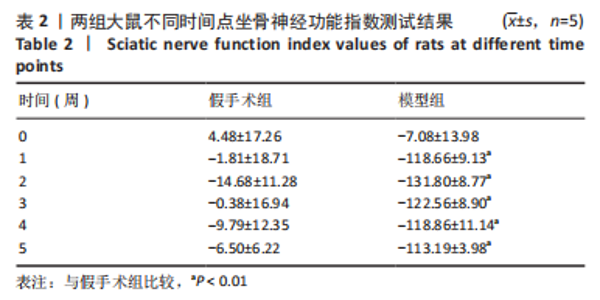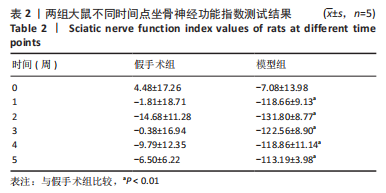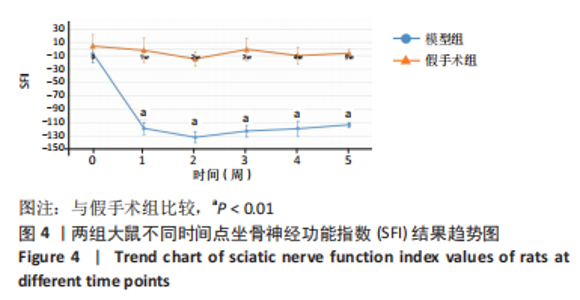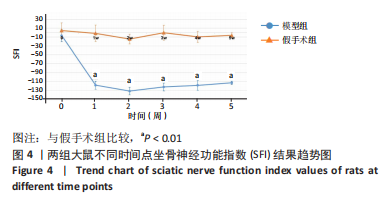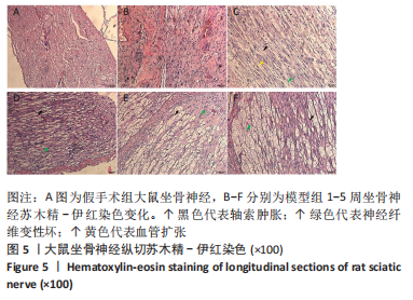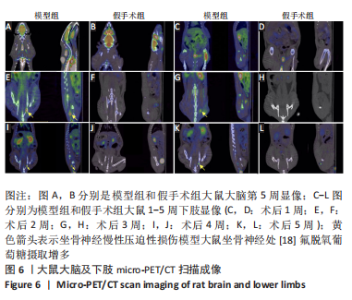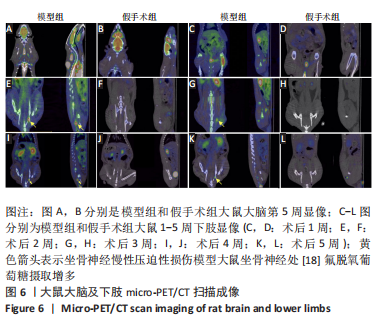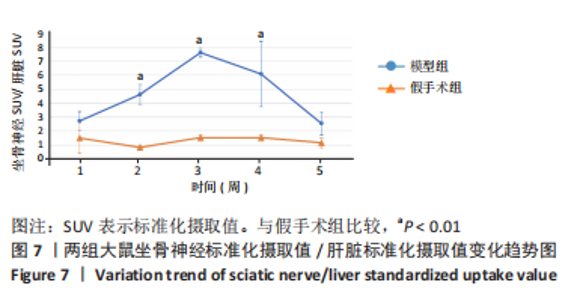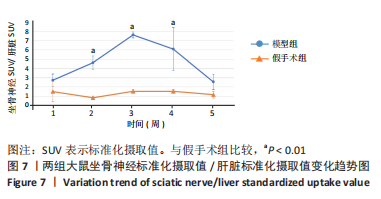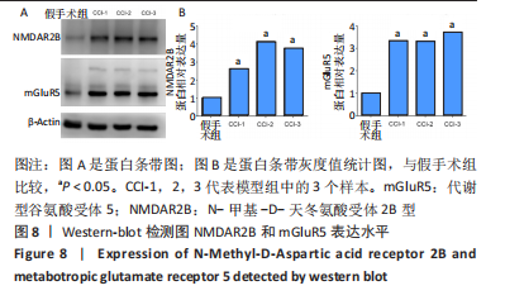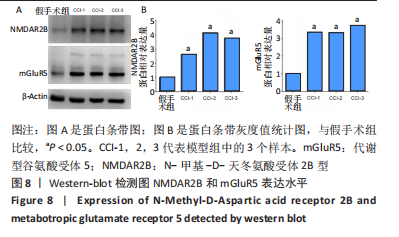Chinese Journal of Tissue Engineering Research ›› 2023, Vol. 27 ›› Issue (20): 3216-3223.doi: 10.12307/2023.410
Previous Articles Next Articles
Depression-like behavior characteristics of rats with neuropathic pain and expression of mGluR5 and NMDAR2B in the left dorsal agranular insular area
Hu Yue, Zhu Yuanliang, Wan Tenggang, Xu Fangyuan, Xu Zhangyu, Li Jiyang, Li Dan, Wang Jianxiong
- Department of Rehabilitation Medicine, the Affiliated Hospital of Southwest Medical University, Luzhou 646000, Sichuan Province, China
-
Received:2022-05-07Accepted:2022-06-20Online:2023-07-18Published:2022-11-19 -
Contact:Wang Jianxiong, MD, Associate professor, Department of Rehabilitation Medicine, the Affiliated Hospital of Southwest Medical University, Luzhou 646000, Sichuan Province, China -
About author:Hu Yue, Master, Technician, Department of Rehabilitation Medicine, the Affiliated Hospital of Southwest Medical University, Luzhou 646000, Sichuan Province, China -
Supported by:School-level Scientific Research Project of Southwest Medical University, No. 2021ZKQN042 (to HY); Youth Innovation Research Project of Sichuan Medical Association, No. Q19035 (to WJX); Youth Project of Affiliated Hospital of Southwest Medical University, No. 2019ZQN110 (to WJX)
CLC Number:
Cite this article
Hu Yue, Zhu Yuanliang, Wan Tenggang, Xu Fangyuan, Xu Zhangyu, Li Jiyang, Li Dan, Wang Jianxiong. Depression-like behavior characteristics of rats with neuropathic pain and expression of mGluR5 and NMDAR2B in the left dorsal agranular insular area[J]. Chinese Journal of Tissue Engineering Research, 2023, 27(20): 3216-3223.
share this article
Add to citation manager EndNote|Reference Manager|ProCite|BibTeX|RefWorks
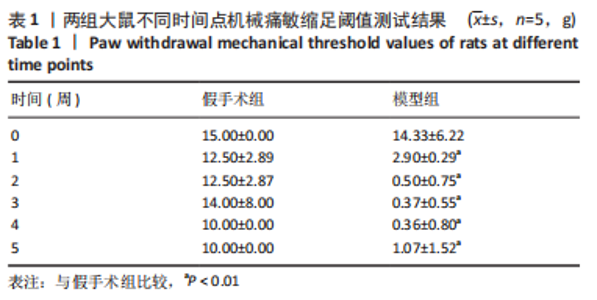
2.1 实验动物数量分析 研究共有50只大鼠(假手术组25只,模型组25只)完成实验。 2.2 模型大鼠神经病理性疼痛及抑郁样行为 两组大鼠术前机械刺激缩足阈值差异无显著性意义(P > 0.05)。假手术组大鼠术后1-5周机械刺激缩足阈值略有下降,考虑与手术切口、切口缝合有关。与术前比较,模型组大鼠术后1周机械痛敏缩足阈值显著降低,且明显低于假手术组(P < 0.05),术后第2周机械痛敏缩足阈值继续下降,与术后1周及假手术组比较差异均有显著性意义(P < 0.05),提示模型组大鼠术后1周即出现明显神经病理性疼痛,第2周疼痛持续加重;术后3-5周模型组大鼠机械痛敏缩足阈值仍显著低于假手术组,但机械痛敏缩足阈值未再持续降低,提示神经病理性疼痛程度未再加重,相对稳定,见表1和图3A。"
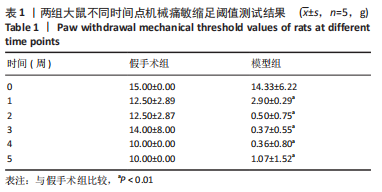
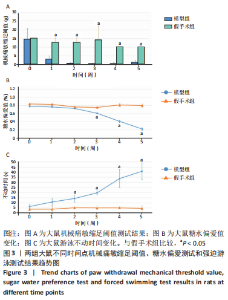
两组大鼠糖水偏爱度及游泳不动时间在术前差异无显著性意义(P > 0.05)。假手术组大鼠术后1-5周糖水偏爱度及游泳不动时间较术前差异无显著性意义,观察期间整体波动很小,提示无明显抑郁样行为。模型组大鼠糖水偏爱度术后一两周较术前及假手术组差异无显著意义,自术后3周开始下降,且明显低于术前及假手术组(P < 0.05),术后第4,5周糖水偏爱度继续下降。模型组大鼠游泳不动时间自术后2周开始明显延长,且在术后3-5周持续延长,并显著高于假手术组。以上结果提示坐骨神经慢性压迫性损伤模型大鼠在神经病理性疼痛出现两三周才开始出现明显的抑郁样行为;尽管实验后期疼痛相对稳定,而抑郁样行为在逐渐加重,见图3B,C。"
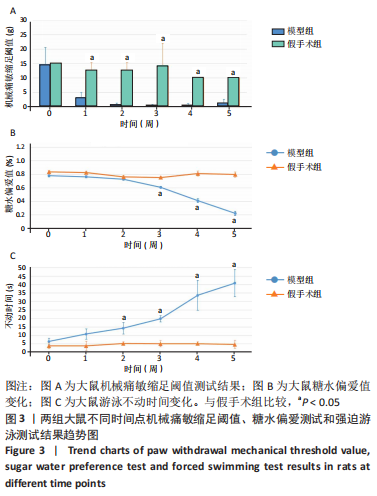
| [1] MORI N, HOSOMI K, NISHI A, et al. Analgesic Effects of Repetitive Transcranial Magnetic Stimulation at Different Stimulus Parameters for Neuropathic Pain: A Randomized Study. Neuromodulation. 2022;25(4):520-527. [2] ZHANG W, SUO M, YU G, et al. Antinociceptive and anti-inflammatory effects of cryptotanshinone through PI3K/Akt signaling pathway in a rat model of neuropathic pain. Chem Biol Interact. 2019;305:127-133. [3] SAMPSON SM, KUNG S, MCALPINE DE, et al. The use of slow-frequency prefrontal repetitive transcranial magnetic stimulation in refractory neuropathic pain. J ect. 2011;27(1):33-37. [4] 郭铁成, 许惊飞. 低频和高频重复经颅磁刺激对大鼠神经病理性疼痛及背根神经节内nNOS的影响[J]. 中华物理医学与康复杂志,2014,36(11): 823-8273. [5] BOUHASSIRA D. Neuropathic pain: Definition, assessment and epidemiology. Rev Neurol (Paris). 2019;175(1-2):16-25. [6] HSU JH, DASKALAKIS ZJ, BLUMBERGER DM. An Update on Repetitive Transcranial Magnetic Stimulation for the Treatment of Co-morbid Pain and Depressive Symptoms. Curr Pain Headache Rep. 2018;22(7):51. [7] LI J X. Pain and depression comorbidity: a preclinical perspective. Behav Brain Res. 2015;276:92-98. [8] HUMO M, LU H, YALCIN I. The molecular neurobiology of chronic pain-induced depression. Cell Tissue Res. 2019;377(1):21-43. [9] SEMINOWICZ DA, DE MARTINO E, SCHABRUN SM, et al. Left dorsolateral prefrontal cortex repetitive transcranial magnetic stimulation reduces the development of long-term muscle pain. Pain. 2018;159(12):2486-2492. [10] SEMINOWICZ D A, MOAYEDI M. The Dorsolateral Prefrontal Cortex in Acute and Chronic Pain. J Pain. 2017;18(9):1027-1035. [11] LAUBACH M, AMARANTE L M, SWANSON K, et al. What, If Anything, Is Rodent Prefrontal Cortex? eNeuro. 2018;5(5):ENEURO.0315-18.2018. [12] 祝建平. 束缚-浸水应激大鼠内侧前额叶皮质对胃机能的调控作用及机制的研究[D].济南:山东师范大学,2015. [13] OBARA I, GOULDING SP, HU JH, et al. Nerve injury-induced changes in Homer/glutamate receptor signaling contribute to the development and maintenance of neuropathic pain. Pain. 2013;154(10):1932-1945. [14] LARSSON M, BROMAN J. Synaptic plasticity and pain: role of ionotropic glutamate receptors. Neuroscientist. 2011;17(3):256-273. [15] PEREIRA V, GOUDET C. Emerging Trends in Pain Modulation by Metabotropic Glutamate Receptors. Front Mol Neurosci. 2018;11:464. [16] GONG K, KUNG L H, MAGNI G, et al. Increased response to glutamate in small diameter dorsal root ganglion neurons after sciatic nerve injury. PLoS One. 2014;9(4):e95491. [17] GIORDANO C, CRISTINO L, LUONGO L, et al. TRPV1-dependent and -independent alterations in the limbic cortex of neuropathic mice: impact on glial caspases and pain perception. Cereb Cortex. 2012;22(11): 2495-2518. [18] INQUIMBERT P, BARTELS K, BABANIYI OB, et al. Peripheral nerve injury produces a sustained shift in the balance between glutamate release and uptake in the dorsal horn of the spinal cord. Pain. 2012;153(12):2422-2431. [19] XIE JD, CHEN SR, PAN HL. Presynaptic mGluR5 receptor controls glutamatergic input through protein kinase C-NMDA receptors in paclitaxel-induced neuropathic pain. J Biol Chem. 2017;292(50):20644-20654. [20] FONSECA-RODRIGUES D, AMORIM D, ALMEIDA A, et al. Emotional and cognitive impairments in the peripheral nerve chronic constriction injury model (CCI) of neuropathic pain: A systematic review. Behav Brain Res. 2021;399:113008. [21] AUSTIN PJ, WU A, MOALEM-TAYLOR G. Chronic constriction of the sciatic nerve and pain hypersensitivity testing in rats. J Vis Exp. 2012;(61):3393. [22] MEDEIROS P, DOS SANTOS IR, JÚNIOR IM, et al. An Adapted Chronic Constriction Injury of the Sciatic Nerve Produces Sensory, Affective, and Cognitive Impairments: A Peripheral Mononeuropathy Model for the Study of Comorbid Neuropsychiatric Disorders Associated with Neuropathic Pain in Rats. Pain Med. 2021;22(2):338-351. [23] IÑIGUEZ SD, FLORES-RAMIREZ FJ, RIGGS LM, et al. Vicarious Social Defeat Stress Induces Depression-Related Outcomes in Female Mice. Biol Psychiatry. 2018; 83(1):9-17. [24] LIU M Y, YIN C Y, ZHU LJ, et al. Sucrose preference test for measurement of stress-induced anhedonia in mice. Nat Protoc. 2018;13(7):1686-1698. [25] MORENO-SANTOS B, MARCHI-COELHO C, COSTA-FERREIRA W, et al. Angiotensinergic receptors in the medial amygdaloid nucleus differently modulate behavioral responses in the elevated plus-maze and forced swimming test in rats. Behav Brain Res. 2021;397:112947. [26] CUI M, LIANG J, XU D, et al. NLRP3 inflammasome is involved in nerve recovery after sciatic nerve injury. Int Immunopharmacol. 2020;84:106492. [27] TSUANG FY, CHEN MH, LIN FH, et al. Partial enzyme digestion facilitates regeneration of crushed nerve in rat. Transl Neurosci. 2020;11(1):251-263. [28] KREMER M, BECKER LJ, BARROT M, et al. How to study anxiety and depression in rodent models of chronic pain?. Eur J Neurosci. 2021;53(1): 236-270. [29] LI Q, YUE N, LIU SB, et al. Effects of chronic electroacupuncture on depression- and anxiety-like behaviors in rats with chronic neuropathic pain. Evid Based Complement Alternat Med. 2014;2014:158987. [30] LI Y, CHEN C, LI S, et al. Ginsenoside Rf relieves mechanical hypersensitivity, depression-like behavior, and inflammatory reactions in chronic constriction injury rats. Phytother Res. 2019;33(4):1095-1103. [31] FUKUHARA K, ISHIKAWA K, YASUDA S, et al. Intracerebroventricular 4-methylcatechol (4-MC) ameliorates chronic pain associated with depression-like behavior via induction of brain-derived neurotrophic factor (BDNF). Cell Mol Neurobiol. 2012;32(6):971-977. [32] GARG S, DESHMUKH VR, PRASOON P. Possible modulation of PPAR-γ cascade against depression caused by neuropathic pain in rats. J Basic Clin Physiol Pharmacol. 2017;28(6):593-600. [33] WANG C, CHEN P, LIN D, et al. Effects of varying degrees of ligation in a neuropathic pain model induced by chronic constriction injury. Life Sci. 2021;276:119441. [34] CHERIF F, ZOUARI HG, CHERIF W, et al. Depression Prevalence in Neuropathic Pain and Its Impact on the Quality of Life. Pain Res Manag. 2020;2020:7408508. [35] LEUNG A, METZGER-SMITH V, HE Y, et al. Left Dorsolateral Prefrontal Cortex rTMS in Alleviating MTBI Related Headaches and Depressive Symptoms. Neuromodulation. 2018;21(4):390-401. [36] BRIGHINA F, DE TOMMASO M, GIGLIA F, et al. Modulation of pain perception by transcranial magnetic stimulation of left prefrontal cortex. J Headache Pain. 2011;12(2):185-191. [37] DE MARTINO E, SEMINOWICZ DA, SCHABRUN SM, et al. High frequency repetitive transcranial magnetic stimulation to the left dorsolateral prefrontal cortex modulates sensorimotor cortex function in the transition to sustained muscle pain. Neuroimage. 2019;186:93-102. [38] ZHU CZ, WILSON SG, MIKUSA JP, et al. Assessing the role of metabotropic glutamate receptor 5 in multiple nociceptive modalities. Eur J Pharmacol. 2004;506(2):107-118. [39] CHUNG G, KIM SJ, KIM SK. Metabotropic Glutamate Receptor 5 in the Medial Prefrontal Cortex as a Molecular Determinant of Pain and Ensuing Depression. Front Mol Neurosci. 2018;11:376. [40] CHUNG G, KIM CY, YUN YC, et al. Upregulation of prefrontal metabotropic glutamate receptor 5 mediates neuropathic pain and negative mood symptoms after spinal nerve injury in rats. Sci Rep. 2017;7(1):9743. [41] 车银伟, 蔡国洪, 王鑫,等. 神经病理性痛条件下前额叶皮质内代谢型谷氨酸受体第5亚型的表达及分布变化[J]. 神经解剖学杂志,2016, 32(3):301-306. [42] 王云霞, 付淼, 罗芳. 脉冲射频对坐骨神经慢性压迫模型大鼠的痛觉过敏及脊髓背角NR2B亚基表达的作用[J]. 中国康复理论与实践,2016, 22(9):1020-1023. [43] WANG XY, ZHOU HR, WANG S, et al. NR2B-Tyr phosphorylation regulates synaptic plasticity in central sensitization in a chronic migraine rat model. J Headache Pain. 2018;19(1):102. [44] NIU Y, ZENG X, ZHAO L, et al. Metabotropic glutamate receptor 5 regulates synaptic plasticity in a chronic migraine rat model through the PKC/NR2B signal. J Headache Pain. 2020;21(1):139. [45] 黄敏, 许涛, 江伟. 代谢型谷氨酸受体5与N-甲基-D-天冬氨酸受体的关系及其在疾病中的作用[J]. 上海交通大学学报(医学版),2018,38(7): 825-828. [46] HOOKER JM, CARSON RE. Human Positron Emission Tomography Neuroimaging. Annu Rev Biomed Eng. 2019;21:551-581. [47] KIM C E, KIM Y K, CHUNG G, et al. Large-scale plastic changes of the brain network in an animal model of neuropathic pain. Neuroimage. 2014; 98:203-215. [48] BEHERA D, JACOBS KE, BEHERA S, et al. (18)F-FDG PET/MRI can be used to identify injured peripheral nerves in a model of neuropathic pain. J Nucl Med. 2011;52(8):1308-1312. [49] LEE S H, SEO HG, OH BM, et al. (18)F-FDG positron emission tomography as a novel diagnostic tool for peripheral nerve injury. J Neurosci Methods. 2019;317:11-19. |
| [1] | He Xi, Wan Yu, Tang Yuting, Yang Anning, Wu Kai, Jiao Yun, Bai Zhigang, Jiang Yideng, Shen Jiangyong. Erastin inhibits proliferation of hypertrophic scar fibroblasts [J]. Chinese Journal of Tissue Engineering Research, 2023, 27(在线): 1-. |
| [2] | Jiang Xiaocheng, Shi Lu, Wang Yinbin, Li Qiujiang, Xi Chuangzhen, Ma Zefeng, Cai Lijun. Systematical evaluation of bone fusion rate after interbody fusion in patients with osteoporosis and lumbar degenerative disease treated with teriparatide [J]. Chinese Journal of Tissue Engineering Research, 2023, 27(9): 1427-1433. |
| [3] | Zhong Yizheng, Huang Peizhen, Cai Qunbin, Zheng Liqin, He Xingpeng, Dong Hang. Microstructural indexes that determine the trabecular bone maximum stress of micro-finite element models [J]. Chinese Journal of Tissue Engineering Research, 2023, 27(9): 1313-1318. |
| [4] | Cao Sheng, Kong Lingwei, Xu Kun, Sun Zhijie. Correlation of cervical sagittal force line parameters with degenerative segment and Pfirrmann classification in patients with cervical intervertebral disc degeneration [J]. Chinese Journal of Tissue Engineering Research, 2023, 27(9): 1319-1324. |
| [5] | Ke Yuqi, Chen Changjian, Wu Hao, Zheng Lianjie. Comparison of 12-month follow-up results of primary total hip arthroplasty between modified direct anterior approach and direct anterior approach [J]. Chinese Journal of Tissue Engineering Research, 2023, 27(9): 1377-1382. |
| [6] | Zhang Lichuang, Gao Huali, Wang Jingchao, Lin Huijun, Wu Chonggui, Ma Yinghui, Huang Yunfei, Fang Xue, Zhai Weitao. Effect of tendon manipulation with equal emphasis on muscles and bones on accelerating the functional rehabilitation of quadriceps femoris after total knee arthroplasty [J]. Chinese Journal of Tissue Engineering Research, 2023, 27(9): 1383-1389. |
| [7] | Du Xueting, Zhang Xiaodong, Chen Yanjun, Wang Mei, Chen Wubiao, Huang Wenhua. Application of compressed sensing technology in two-dimensional magnetic resonance imaging of the ankle joint [J]. Chinese Journal of Tissue Engineering Research, 2023, 27(9): 1396-1402. |
| [8] | You Zhengqiu, Zhang Zhongzu, Wang Qunbo. Early symptomatic intervertebral disc pseudocysts after discectomy detected on MRI [J]. Chinese Journal of Tissue Engineering Research, 2023, 27(9): 1403-1409. |
| [9] | Li Chao, Zhang Peipei, Xu Mengting, Li Linlin, Ding Jiangtao, Liu Xihua, Bi Hongyan. Respiratory training improves morphological changes of the multifidus muscle in patients with chronic nonspecific lower back pain assessed by musculoskeletal ultrasound [J]. Chinese Journal of Tissue Engineering Research, 2023, 27(9): 1417-1421. |
| [10] | He Yinhao, Li Xiaosheng, Chen Hongwen, Chen Tiezhu. 3D printed porous tantalum metal in the treatment of developmental dysplasia of the hip: current status and application prospect [J]. Chinese Journal of Tissue Engineering Research, 2023, 27(9): 1455-1461. |
| [11] | Lian Shilin, Zhang Yan, Jiang Qiang, Zhang Hanshuo, Li Tusheng, Ding Yu. Interventional effects of whole blood and platelet-rich plasma with different preparation methods on nucleus pulposus cells [J]. Chinese Journal of Tissue Engineering Research, 2023, 27(8): 1199-1204. |
| [12] | Wu Dongzhe, Gao Xiaolin, Li Chuangtao, Wang Hao. Constructing the prediction model of maximal oxygen uptake by back-propagation neural network based on the cardiorespiratory optimal point [J]. Chinese Journal of Tissue Engineering Research, 2023, 27(8): 1224-1231. |
| [13] | Yang Jiujie, Li Zhi, Wang Shujie, Tian Ye, Zhao Wei. Intraoperative neurophysiological monitoring of functional changes following durotomy with decompression for acute spinal cord injury [J]. Chinese Journal of Tissue Engineering Research, 2023, 27(8): 1232-1236. |
| [14] | Li Mengfei, Zhang Hong, Zhao Shaojian, Yin Guanghao, Wang Qibao. Expression of forkhead box protein 3 in refractory periapical periodontitis in rats with Enterococcus faecalis infection [J]. Chinese Journal of Tissue Engineering Research, 2023, 27(8): 1187-1192. |
| [15] | Liu Xiaolin, Mu Xinyue, Ma Ziyu, Liu Shutai, Wang Wenlong, Han Xiaoqian, Dong Zhiheng. Effect of hydrogel-loaded simvastatin microspheres on osteoblast proliferation and differentiation [J]. Chinese Journal of Tissue Engineering Research, 2023, 27(7): 998-1003. |
| Viewed | ||||||
|
Full text |
|
|||||
|
Abstract |
|
|||||
